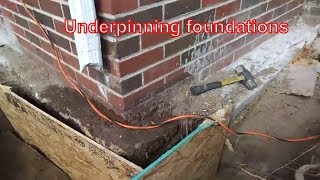Before starting any construction project, you should know what is underpinning. Underpinning
helps to prevent a building moving or from settling. This process requires a thorough evaluation
of the existing structural strength of a building. Temporary support is provided through strutting
or shoring. This should not cause any damage in nearby structures or areas. Before you
underpin your building, it is a good idea consult a structural engineer.
Underpinning Melbourne is typically used to support structures that are built on a weakened foundation. In the case of Grand Central Station, for example, the subway structure is the foundation of the
Hotel Commodore. This historic structure was extensively renovated and reopened in 1979 as
the Grand Hyatt. To stabilize the structure and allow for more passengers to flow, underpinning
was used. The building was divided into sections measuring approximately 1.2 to 1.5 meters in
length.
Methods of Underpinning
Underpinning is a method of digging holes under the foundation to prevent a building’s shifting.
These holes are filled with concrete and reinforcing materials. Underpinning can be done by
hand or with heavy excavation equipment. This type of project requires extensive knowledge
and should only be handled by specialized contractors. You may not feel comfortable hiring a
contractor. We have some tips to help you find a qualified contractor.
Although it is more costly, the mini-pile method can be used in unstable ground conditions. Mini-
pile underpinning involves driving deep, vertical structural elements into the ground. To connect the piles, a ring beam is built. Finally, a concrete-filled pit will be poured to transfer the load from
piers to wall. This method is often a more costly option, as it requires more expertise and
specialty equipment.
Subsidence and water level are the most common reasons for underpinning houses. All types of
underpinning have the same purpose: to distribute the building’s weight to a support. For
example, mass concrete underpinning involves excavations beneath the foundation of a house
and concrete filling these sections. This method can be extremely effective for houses with
shallow foundations, even though it is a slow process.
If these signs are present in your home, it’s likely that your home is in need of underpinning. If
you notice gaps around doors or windows, you should seek professional help as soon as
possible to prevent further damage. Although it may be tempting to fix the problem yourself, it is
best to have a professional assess the situation. This will allow the structure regain equilibrium.
Professional Contractor
For a professional assessment, contact a qualified structural engineer if you are unsure.
Underpinning can be a cost-effective solution for shaky foundations. It is a cost-effective solution
for structures and buildings that are under stress or have significant uneven settlement. Piles,
micropiles, or even a steel beam are all ways to transfer loads to one level. Sometimes it’s
necessary to lower the foundation by moving ground adjacent.
There are many benefits and drawbacks to underpinning your home. Although it is costly, it can
reduce your risk of structural problems. While you can choose a higher insurance premium if you
live in a high-risk area, you still have to bear in mind that underpinning is not a guarantee of a
stable future. Before you begin underpinning your home, it is important to seek professional
advice. The process is complex and can lead to further damage. For more information on underpinning, contact Underpinning Solutions.
The process of sub-pinning will vary depending on the type and condition of the soil. Pile and
pier methods are the most reliable. The foundation is where the piers will be placed. These piers
lift and transfer loads to the piers. Some homeowners choose temporary underpinning prior to
underpinning their home. However, temporary underpinning is not a permanent solution. It is
best to consult an expert when you are unsure about your foundation’s stability.
There are many advantages to underpinning. It helps stabilize your foundation in case a
structure has moved during a natural disaster. A qualified structural engineer, or building
surveyor, can determine whether underpinning may be necessary. It can be difficult to insure a
building with a poor foundation, so you should always check it out before purchasing a property.
If underpinning is not done properly, you can incur costs and risk further damage.
